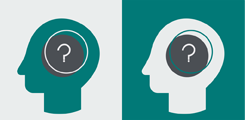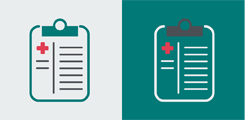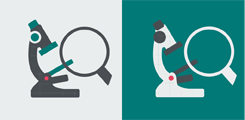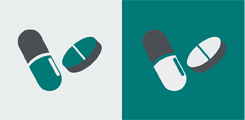Stroke
Stroke, brain haemorrhage, embolism, thrombosis and cerebrovascular accident are the terms used to indicate a sudden vascular problem in an area of the brain. Lack of blood and oxygen can cause brain cells (neurons) to die, causing permanent damage to the brain. Depending on the degree and duration of the decrease in blood flow and the area of the brain affected, the consequences will be more or less serious.
Stroke is the second leading cause of death in Spain, the first in women and the first cause of disability in the adult population. It is also one of the main causes of dementia. One in every 6 people will suffer a stroke throughout their lives, of which 50% will become disabled or die.
Causes
There are two types of vascular diseases in the brain:
- Ischaemic stroke or cerebral infarction: caused by the obstruction of a vessel, due to two main causes: arteriosclerosis and cardiac embolisms. Arteriosclerosis promotes the appearance of thrombi in the vessel walls. Cardiac embolisms occur when the heart has abnormalities in its valves or heart rhythm disorders (arrhythmias), which promote the appearance of clots in the heart, which can reach the brain. Ischaemic stroke represents 85% of strokes.
- Haemorrhagic stroke or brain haemorrhage: it occurs due to the rupture of an artery. It constitutes 15% of stroke cases.
Risk factors:
- High blood pressure: is the most important risk factor, it is estimated that it multiplies the risk of stroke by 5.
- High cholesterol
- Diabetes mellitus
- Smoking
- Excessive alcohol consumption
- Heart diseases: such as some arrhythmias (atrial fibrillation) and heart valve abnormalities.
- Obesity
- Sedentary lifestyle
Symptoms
Each area of the brain controls a different function, which is why symptoms will vary depending on the area affected. We should suspect a stroke when the following symptoms appear suddenly:
- Loss of feeling or strength on one side of the body
- Difficulty speaking or understanding
- Loss of vision in one or both eyes or double vision
- Instability and difficulty walking
- Sudden, very intense headache, different from previous pain
Diagnosis
Neuroimaging tests allow us to differentiate an infarction from a brain haemorrhage. For this purpose, computerized axial tomography (brain CT) scan or magnetic resonance imaging (brain MRI) are used, which will allow us to see where the problem is located, and angioCT or angioMRI, which give a detailed picture of the blood vessels.
Once it has been confirmed that it is a stroke, several tests will be carried out (blood tests, cardiological study, Doppler ultrasound of supraaortic vessels) to search for the cause.
Treatment
Prevention
As with other diseases, the best treatment begins with prevention. 80% of stroke cases can be avoided by controlling vascular risk factors, with the following life habits:
Quitting smoking
- Avoiding high alcohol intake
- Healthy diet, rich in fruits and vegetables and low in saturated fats
- Performing regular physical activity (e.g. walking or swimming at a moderate intensity 30 minutes a day)
- Regularly monitoring blood pressure, heart rate, glucose and cholesterol
- Taking appropriate medication indicated by your doctor to control vascular risk factors.
Treatment
Stroke is a medical emergency, since the effectiveness of treatment will depend on how quickly it is diagnosed and treated. The patient must be urgently transferred to a hospital that has the appropriate means for treatment. This treatment will be different if it is an ischaemic stroke or a haemorrhagic stroke.
Treatment of ischaemic stroke
The treatment of ischaemic stroke consists of two phases, the first aimed at opening the vessel that has been blocked to re-establish circulation in the brain (revascularization treatment) and the second that aims to prevent another stroke from occurring again (secondary prevention).
Revascularization treatment:
It can only be administered within the first hours of the stroke.
-
- Intravenous thrombolysis: it consists of the administration of a drug (plasminogen tissue activator) that dissolves the thrombus through a vein.
- Mechanical thrombectomy: it is used when intravenous thrombolysis has not worked and/or there is an occlusion of the largest arteries in the brain. The procedure involves inserting a catheter through an artery in the groin, which will be guided by X-ray to the occluded vessel, to remove the thrombus.
Secondary prevention treatments:
Drugs are used to prevent the appearance of new thrombi (anti-aggregating agents or anticoagulants) and to control vascular risk factors (antihypertensive drugs, anti-diabetic drugs and anti-hypercholesterolaemia drugs).
Treatment of haemorrhagic stroke
Treatment will depend on the location of the haemorrhage. If it is a subarachnoid haemorrhage secondary to the rupture of an aneurysm, a catheterization will be performed through the femoral artery, to reach the point of arterial rupture and proceed to sealing it, with different techniques, such as the use of coils. When it cannot be treated with this method, the aneurysm will be excluded through surgery.
In cases where the haemorrhage is inside the brain, the indication of surgical intervention to evacuate the haematoma will be individualized.
Rehabilitation
After a stroke, one third of people have a satisfactory recovery, another third have serious sequelae and the other third of strokes are fatal.
The sequelae of stroke are very varied and include problems that affect mobility, speech, vision or swallowing, mood swings and cognitive impairment.
Rehabilitation after stroke is aimed at ensuring that the person achieves maximum independence and integration within their family, social and work environment. It will start as soon as possible during hospital admission, as early onset is associated to better results. This is an intensive treatment, carried out by a multidisciplinary team, which includes doctors, nurses, physiotherapists, occupational therapists, neuropsychologists and social workers.
Most of the recovery occurs in the first three months after the stroke. However, it can continue, albeit at a slower rate, up to at least one year.








